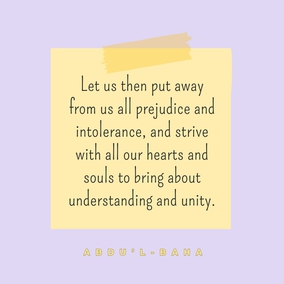The views expressed in our content reflect individual perspectives and do not represent the authoritative views of the Baha'i Faith.
A rough diamond is a jagged, milky white stone that is not especially noteworthy to an inexperienced observer. If you saw one in the wild, you might not even recognize it.
Why not? Well, until they’re cut and polished into a beautifully faceted gem, diamonds don’t sparkle or reflect the brilliant inner light they’re so famous for.
RELATED: The Spiritual Meaning of Gold
Diamonds, among the hardest substances on Earth, are still somewhat brittle. Once uncovered, this characteristic of brittleness along predictable planes in the interior alignment of a diamond’s carbon atoms reveals its ability to capture and display light, and to dazzle viewers.
The discovery of diamonds probably first occurred in the rivers of India at least a thousand years before Christ. Alexander the Great might have brought the first diamonds back to Europe around 400BC, where the ancient Greeks believed that diamonds were teardrops from the gods.

The process of cleaving, or “cutting” a rough diamond is a critical step in the process of revealing the true qualities of the gem it contains. The diamond cutter searches the stone for the best cleavage plane to fracture, then carefully cuts a groove along that line using another diamond – because only diamonds can cut diamonds. The cutter then inserts a steel wedge and sharply strikes it with a mallet. If done correctly, the stone fractures along its natural cleavage.
The careful process required to reveal the beauty of the stone inside and capture and display refracted light so beautifully resembles the process that must be followed to discover many truths.
Always, outward appearances hide inner truths. It requires effort, intellect, and understanding to remove the obscuring layers that uncover the light within. The truth, like the inner quality of a diamond, cannot become visible until this process takes place. Removal of the outer layers and the polishing of a diamond’s facets happens as a result of careful and thoughtful deliberation – and not without some effort.
In an address he gave in 1912, Abdu’l-Baha, the son and successor of Baha’u’llah, the prophet and founder of the Baha’i Faith, described the necessary tools for reaching that inner truth:
The first teaching of Baha’u’llah is the duty incumbent upon all to investigate reality. What does it mean to investigate reality? It means that man must forget all hearsay and examine truth himself, for he does not know whether statements he hears are in accordance with reality or not. Wherever he finds truth or reality, he must hold to it, forsaking, discarding all else; for outside of reality there is naught but superstition and imagination …
God has given man the eye of investigation by which he may see and recognize truth. He has endowed man with ears that he may hear the message of reality and conferred upon him the gift of reason by which he may discover things for himself. This is his endowment and equipment for the investigation of reality. Man is not intended to see through the eyes of another, hear through another’s ears nor comprehend with another’s brain. Each human creature has individual endowment, power and responsibility in the creative plan of God. Therefore, depend upon your own reason and judgment and adhere to the outcome of your own investigation; otherwise, you will be utterly submerged in the sea of ignorance and deprived of all the bounties of God.
There is a word, a spiritual quality, that describes an essential requisite in the process of penetrating distracting outward appearances in order to learn the truth: sagacity.
Sagacity — the ability to thoughtfully discern or perceive an inner reality, to arrive at an insightful understanding that could differ from a popular or more common impression — is a rare quality, valuable in the same way rare diamonds have value. In contemporary culture, we don’t tend to hear the word often. Other expressions like searching for “the light of truth” seem more common. Yet, sagacity represents an especially helpful skill in an environment where sources claiming to be true are contradictory and, more often, when forces that can manipulate our emotions and predilections obscure factual reality.
How do we cultivate and nurture an ability to practice sagacity? The Baha’i writings offer some suggestions and requirements. One of these involves making a deliberate effort to use our minds. It is helpful, though challenging, to be mindful of a natural human inclination toward intellectual laziness. Reacting to situations and accepting news and explanations without critical thought has become especially easy, even more so in our age of technology and information overload. Examples are common in today’s news. Shortly after the national outrage over the death of George Floyd, an African American man last summer, for example, some American lawmakers attempted to demonstrate their support by prominently wearing African kente cloth in a photo op for the Black Lives Matter movement. They failed to realize that kente cloth originates from Ashanti slavers and slave owners in Ghana, and the symbolism contradicted their intended message.
From a Baha’i perspective, we can only avoid this kind of intellectual laziness by employing our mental powers regularly, just as we would use, maintain, and increase our physical powers by getting regular exercise. Baha’u’llah wrote:
First and foremost among these favors, which the Almighty hath conferred upon man, is the gift of understanding. This gift giveth man the power to discern the truth in all things, leadeth him to that which is right, and helpeth him to discover the secrets of creation.
RELATED: How a Search for Truth Gave Me Hope
We can discern the truth more effectively by being mindful of becoming too attached to a personality, no matter how charismatic or compelling that person might be. There are many examples of individuals whose charm, personality, communication and persuasion skills are such that others are drawn to them. Their charisma is often the basis for their celebrity, but their opinions acquire authority that may not be supported by truth.
One such individual, John R. Brinkley, had a charismatic personality that became the engine for a medical scam in the 1930s-1940s which earned millions by pioneering the use of radio to broadcast and magnify his message. In fact, there are many, many examples of individuals capable of influencing others into actions that have regrettable outcomes. Clerics, politicians, social media celebrities, or even someone not in the news can influence our biases and prejudices. We must learn, the Baha’i teachings say, to seek the light rather than the lamp:
In short, it behooves us all to be lovers of truth. Let us seek her in every season and in every country, being careful never to attach ourselves to personalities. Let us see the light wherever it shines, and may we be enabled to recognize the light of truth no matter where it may arise. Let us inhale the perfume of the rose from the midst of thorns which surround it; let us drink the running water from every pure spring.
When we make an effort to think for ourselves, we avoid blind faith. Developing critical thinking skills, and the ability to offer advice on acquiring this ability to others, can help us all analyze information and reach conclusions in order to make better decisions. Sagacity is the personalization of this skill. The value of an insight always becomes richer and more meaningful when it is acquired by our own effort, as the philosopher Arthur Schopenhauer put it in “On Thinking for Oneself”:
For it is only when we gain our knowledge in this way that it enters as an integral part, a living member, into the whole system of our thought; that it stands in complete and firm relation with what we know; that it is understood with all that underlies it and follows from it; that it wears the color, the precise shade, the distinguishing mark, of our own way of thinking; that it comes exactly at the right time, just as we felt the necessity for it; that it stands fast and cannot be forgotten.
In a talk he gave in Paris, Abdul-Baha offered us an example of this search for sagacity:
If a man were to declare, ’There is a lamp in the next room which gives no light’, one hearer might be satisfied with his report, but a wiser man goes into the room to judge for himself, and behold, when he finds the light shining brilliantly in the lamp, he knows the truth!
So the next time the sparkle of a diamond catches your eye, remember that its beauty was only revealed by a careful, laborious process of removing its superficial obscuring layers. By using the analogous mental process of sagacity, we can most assuredly find ways to expose the dazzling light of truth.
















Comments
Sign in or create an account
Continue with Googleor